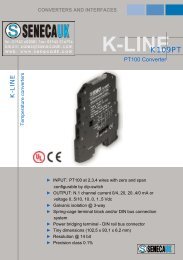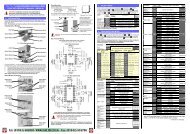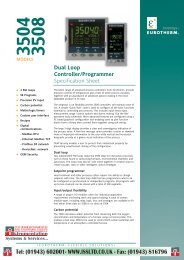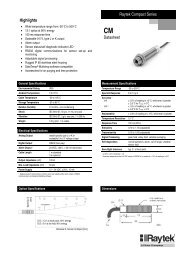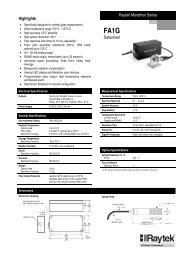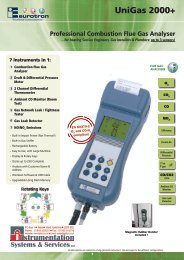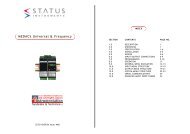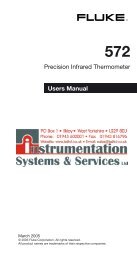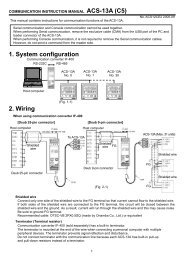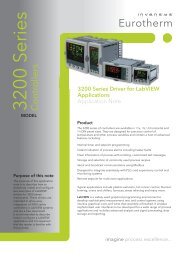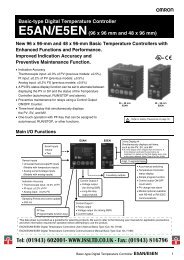to download the Eurotherm piccolo⢠Manual in PDF format
to download the Eurotherm piccolo⢠Manual in PDF format
to download the Eurotherm piccolo⢠Manual in PDF format
Create successful ePaper yourself
Turn your PDF publications into a flip-book with our unique Google optimized e-Paper software.
User <strong>Manual</strong><br />
Piccolo Range<br />
5.2.4 Control<br />
This selects <strong>the</strong> control algorithm, which may be PID heat and/or cool or an ON/OFF. The control algorithm may<br />
also be disabled <strong>in</strong> which case all outputs configured for control will revert <strong>to</strong> off <strong>in</strong> <strong>the</strong> case of a switch<strong>in</strong>g output or<br />
0% power demand <strong>in</strong> <strong>the</strong> case of an analogue output.<br />
P7<br />
Select P7 <strong>to</strong> configure Control Type.<br />
Hav<strong>in</strong>g def<strong>in</strong>ed a control type it will be necessary <strong>to</strong> allocate control outputs us<strong>in</strong>g<br />
P11/P12/P13/P14.<br />
None<br />
HP<br />
CP<br />
HP.CP<br />
Ho.CP<br />
Ho<br />
Co<br />
HP.CO<br />
Ho.Co<br />
Control action disabled<br />
PID heat<strong>in</strong>g<br />
(default)<br />
PID cool<strong>in</strong>g<br />
PID heat + PID cool<br />
ON/OFF heat + PID<br />
cool<br />
ON/OFF heat<strong>in</strong>g<br />
ON/OFF cool<strong>in</strong>g<br />
PID heat + ON/OFF<br />
cool<br />
ON/OFF heat +<br />
ON/OFF cool<br />
The control function block is configured for PID (three<br />
term) heat<strong>in</strong>g, no cool<strong>in</strong>g. Typical applications <strong>in</strong>clude<br />
furnaces and ovens.<br />
The control function block is configured for PID (three<br />
term) cool<strong>in</strong>g, no heat<strong>in</strong>g. May be used <strong>in</strong> cryogenic<br />
applications.<br />
The control function block is configured for PID (three<br />
term) heat<strong>in</strong>g and PID cool<strong>in</strong>g. Typical applications<br />
<strong>in</strong>clude extruder temperature control.<br />
The control function block is configured for ON/OFF<br />
heat<strong>in</strong>g and PID (three term) cool<strong>in</strong>g.<br />
The control function block is configured for ON/OFF<br />
heat<strong>in</strong>g, no cool<strong>in</strong>g. Simple heat only applications.<br />
The control function block is configured for ON/OFF<br />
cool<strong>in</strong>g, no heat<strong>in</strong>g. Simple cool only applications<br />
The control function block is configured for PID (three<br />
term) heat<strong>in</strong>g and ON/OFF cool<strong>in</strong>g. Typical<br />
applications <strong>in</strong>clude extruder temperature control.<br />
The control function block is configured for ON/OFF<br />
heat<strong>in</strong>g and cool<strong>in</strong>g. Simple heat/ cool applications.<br />
Control options are described<br />
<strong>in</strong> section 7.1<br />
P8<br />
Select P8 <strong>to</strong> configure Non L<strong>in</strong>ear Cool<strong>in</strong>g Type.<br />
P8 is only shown if <strong>the</strong> control type, P7, is heat and cool.<br />
The cool<strong>in</strong>g type algorithm matches <strong>the</strong> controller <strong>to</strong> <strong>the</strong> characteristics of <strong>the</strong> cool<strong>in</strong>g<br />
medium. It is typically used <strong>in</strong> <strong>the</strong> control of extruder barrel temperatures where <strong>the</strong><br />
cool<strong>in</strong>g medium may be water, oil or forced air.<br />
L<strong>in</strong> L<strong>in</strong>ear (default) The characterisation of <strong>the</strong> cool output is l<strong>in</strong>ear<br />
oiL Oil<br />
The cool<strong>in</strong>g output is pulsed. Be<strong>in</strong>g non-evaporative,<br />
oil cool<strong>in</strong>g is pulsed <strong>in</strong> a l<strong>in</strong>ear manner. It is deep and<br />
more direct and will not need such a high cool ga<strong>in</strong> as<br />
fan cool<strong>in</strong>g.<br />
H2o<br />
FAn<br />
Water<br />
Forced air (Fan)<br />
The cool<strong>in</strong>g output is pulsed. A complication with<br />
water-cool<strong>in</strong>g comes if <strong>the</strong> zone is runn<strong>in</strong>g well above<br />
100°C.<br />
Usually <strong>the</strong> first few pulses of water will flash off <strong>in</strong><strong>to</strong><br />
steam giv<strong>in</strong>g a greatly <strong>in</strong>creased cool<strong>in</strong>g capacity due<br />
<strong>to</strong> <strong>the</strong> latent heat of evaporation.<br />
When <strong>the</strong> zone settles down, less or even no<br />
evaporation is a possibility and <strong>the</strong> cool<strong>in</strong>g is less<br />
severe.<br />
To handle evaporative cool<strong>in</strong>g, water cool mode would<br />
generally be chosen.<br />
This technique delivers much shortened pulses of<br />
water for <strong>the</strong> first few percent of <strong>the</strong> cool<strong>in</strong>g range,<br />
when <strong>the</strong> water is likely <strong>to</strong> be flash<strong>in</strong>g off <strong>in</strong><strong>to</strong> steam.<br />
This compensates for <strong>the</strong> transition out of <strong>the</strong> <strong>in</strong>itial<br />
strong evaporative cool<strong>in</strong>g.<br />
This is much gentler than water cool<strong>in</strong>g and not so<br />
immediate or decisive because of <strong>the</strong> long heat<br />
transfer path through <strong>the</strong> f<strong>in</strong>ned alum<strong>in</strong>ium cooler and<br />
barrel.<br />
With fan cool<strong>in</strong>g, a cool ga<strong>in</strong> sett<strong>in</strong>g of 3 upwards<br />
would be typical and delivery of pulses <strong>to</strong> <strong>the</strong> blower<br />
would be l<strong>in</strong>ear, i.e. <strong>the</strong> on time would <strong>in</strong>crease<br />
proportionally with percentage cool demand<br />
determ<strong>in</strong>ed by <strong>the</strong> controller.<br />
This is typically used for<br />
extruder applications and is<br />
described fur<strong>the</strong>r <strong>in</strong> section<br />
7.1.6 ‘Cool<strong>in</strong>g Algorithm’.<br />
46 Part No HA031260 Issue 1 May -12



